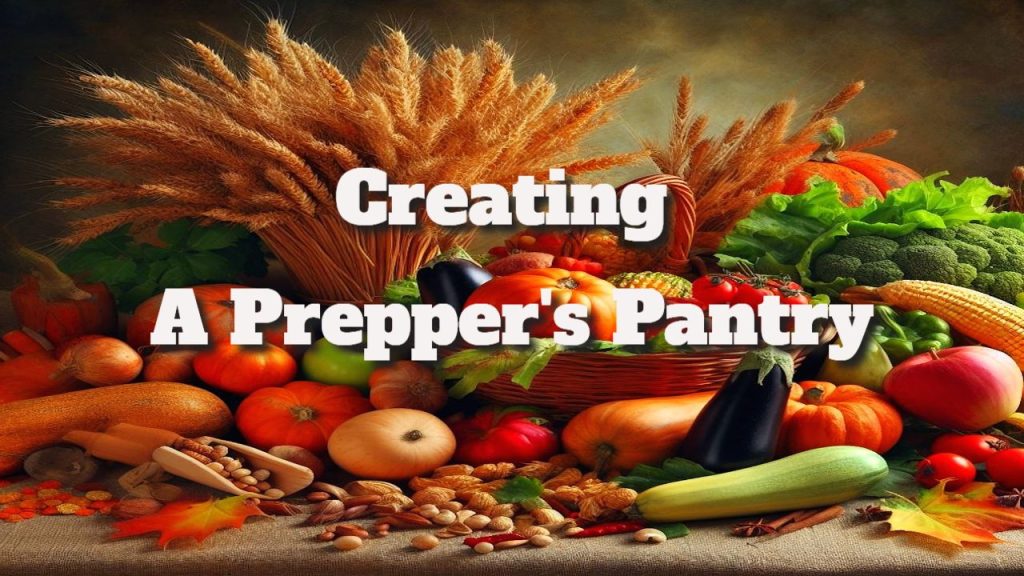Essential Strategies for Designing a High-Performance Prepper’s Pantry
The placement of your pantry plays a pivotal role in preserving the quality, integrity, and longevity of your food supplies. It is paramount to establish an organization system that promotes optimal storage conditions to keep your food items fresh and prevent spoilage. Environments characterized by high humidity and elevated temperatures create ideal conditions for bacteria and fungi, which can accelerate the deterioration of your food. Furthermore, exposure to light can instigate photodegradation, a process that damages food and its packaging, leading to a reduction in essential nutrients, vitamins, and even the appealing colors of your supplies. To mitigate these risks, it is advisable to implement thick curtains or window shutters to effectively block direct sunlight. By creating a cool, dark environment in your pantry, you can significantly enhance the preservation of your food items, thereby extending their shelf life and maintaining their quality for future culinary endeavors.
In addition to light exposure, selecting a pantry location that experiences minimal temperature fluctuations is crucial for preserving the integrity of your food supplies. Constant temperature changes can be equally detrimental to food preservation as exposure to light and heat. Therefore, it is best to avoid placing your pantry in areas that are prone to temperature swings, such as garages, where conditions can vary dramatically. Many seasoned preppers opt for the cooler parts of their homes, such as basements or attics, which not only help maintain a stable temperature but also provide added protection during unforeseen power outages. Furthermore, investing in quality shelving can greatly improve the organization within your pantry, making it easier to locate and access supplies when needed. By implementing these straightforward yet effective strategies, you can create a highly efficient pantry system that caters to your long-term food storage requirements and enhances your overall preparedness.
Innovative Space-Efficient Solutions for Food Storage in Limited Areas
If you find yourself in a living situation lacking a basement, attic, or sufficient storage space, you may be questioning how to effectively store your food supplies without compromising on quality. Many preppers face space constraints, but with a touch of creativity and resourcefulness, nearly any unused area in your home can be transformed into a highly functional food storage solution. For example, consider utilizing the cupboard under your stairs, an old wardrobe, or even a crawl space if you have access to one. These often-overlooked spaces can serve as excellent storage options that maximize your available square footage. Additionally, enhancing existing furniture with pull-out shelves and vertical storage solutions can significantly optimize space efficiency. Think about incorporating pull-out racks specifically designed for can storage that can fit neatly underneath your bed, ensuring you make the most of every inch available while keeping your supplies organized and accessible.
Selecting Optimal Storage Containers for Your Pantry Essentials
With a clearer understanding of the types of food to store and their ideal locations, the next step is to identify the most suitable storage solutions for your specific needs. It is crucial to have a variety of containers, including standard cans, sturdy plastic bins, and glass jars, which are particularly beneficial for freezing food and extending its shelf life. These containers not only aid in preserving food but also serve to prevent contamination and spoilage, ensuring that your supplies remain fresh for an extended period. By investing in high-quality storage supplies, you can create a well-organized pantry that meets not only your immediate food preservation needs but also aligns with your long-term survival goals, providing you peace of mind during challenging times.
Enhancing Food Longevity with Mylar Bags for Extended Storage
Mylar bags are recognized as one of the most favored options for long-term food storage due to their unique properties. By choosing to store some of your food supplies in Mylar bags, you can take advantage of the many benefits they provide. These metallized bags are made from materials akin to those used in space blankets, offering a lightweight yet remarkably durable solution. Their impressive tensile strength ensures they resist tearing or breaking, making them ideal for safeguarding your food against solar damage and oxidation. Mylar bags come in a variety of sizes and thicknesses, with popular options including 1-gallon bags featuring ziplock closures and larger 5-gallon bags designed for lining food storage buckets. When selecting Mylar bags, it is advisable to opt for thicknesses of 4.3 mils or greater, as these thicker bags offer enhanced protection, albeit at a slightly higher price point. Keep your specific storage needs in mind when choosing the right Mylar bags for your provisions.
Mylar bags are particularly effective for repackaging a variety of dry goods, including grains and beans, as well as baked items such as flour, sugar, and baking powder. Additionally, these bags can serve as a reliable storage option for medications, especially light-sensitive items like antibiotics and vitamins. However, it is essential to remember that Mylar bags typically do not come with zippers. Consequently, to seal them properly, you will need either a heat sealer or, as a more budget-friendly alternative, a standard iron. When sealing Mylar bags, be sure to leave a few inches at the top for sealing purposes. It is crucial to test the heat settings to ensure that the seal forms correctly without damaging the bags. Moreover, verify that the edges of the bags are smooth and free from debris before sealing, as this can help prevent cracks or leaks that could jeopardize the contents. To further enhance the shelf life of your stored items, consider incorporating an oxygen absorber into the bags before sealing.
Utilizing 5-Gallon Buckets for Reliable Food Storage Solutions
5-gallon buckets offer an exceptional option for food storage, providing a robust solution for shielding food from heat, moisture, and pests. When utilized correctly, these buckets can create an airtight environment that is crucial for maintaining the quality of your food supplies. Typically, the lids for these buckets are secured using a rubber mallet, and having a lid remover can be advantageous, as the lids can sometimes be difficult to detach. Exercise caution when using used buckets, as they may have damaged or missing lids. You can either purchase standard lids separately or opt for gamma lids, which offer a twist-on, twist-off feature for easy access. While gamma lids may come at a slightly higher cost, they provide superior protection and convenience for your food storage needs. As previously mentioned, lining the interiors of these buckets with Mylar bags can significantly enhance their efficacy. It is advisable to store a diverse array of items in these buckets, such as cereals, granola, flour, sugar, and even liquids like vegetable oil. Multiple Mylar bags can even be placed within a single bucket, provided that the buckets are made from food-grade plastic to prevent any harmful chemicals from leaching into your food.
One of the primary advantages of utilizing 5-gallon buckets is their affordability; many can be acquired for little to no cost. However, when repurposing a food bucket, ensure it has only been used for food items. Avoid using buckets that previously contained hazardous materials, as these can pose serious health risks. Additionally, refrain from stacking these buckets too high to prevent damaging the lids or compromising the integrity of the stored food. Remember to label each bucket clearly to avoid confusion and ensure easy access to your supplies when you need them most.
Enhancing Food Preservation with Oxygen Absorbers in Your Storage System
Integrating oxygen absorbers into your food storage solutions can significantly enhance their effectiveness and longevity. These simple yet powerful tools are instrumental in extending the shelf life of your food items. Oxygen-rich environments promote the growth of harmful bacteria and fungi, which can lead to spoilage. For instance, fruits like apples and potatoes can become discolored and lose their quality when they come into contact with air due to the oxidation process, which alters their vitamins, flavor, and overall nutritional value. To counteract this problem, oxygen absorbers can be utilized. These convenient sachets contain iron powder, which effectively absorbs oxygen and creates a low-oxygen environment, thereby slowing down spoilage. You can store oxygen absorbers alongside your perishable foods, and for dry goods, placing one or two absorbers on top of the items before sealing is a practical strategy to extend their freshness.
The Article Prepper’s Pantry: Essential Tips for Stocking Up Appeared First On Survival Avenue.
The post Essential Tips for Stocking Up Your Prepper’s Pantry appeared first on Survival Bite.
The Article Stocking Up Your Prepper’s Pantry: Essential Tips Was Found On https://limitsofstrategy.com



You bring up such a crucial point regarding the storage environment of a prepper’s pantry! I’ve always found the specifics of pantry organization fascinating, especially considering how easily overlooked they can be in discussions about food preservation. A well-thought-out space can make such a difference.
You highlight an interesting aspect of prepping that often gets lost in the shuffle. The storage environment of a pantry can dramatically impact not just the longevity of food but also the overall efficiency of meal prep. I’ve found that having a well-organized space helps me not only know what I have on hand but also encourages me to use ingredients that might otherwise get overlooked.
You bring up a crucial point about the role of the storage environment in a pantry, and it’s something that doesn’t always get the attention it deserves. The way we organize our spaces can really transform how we approach meal prep.
You bring up such a valuable point about the importance of the storage environment in your pantry. I’ve experienced firsthand how an organized space can transform meal prep from a chore into something enjoyable and efficient. It’s intriguing how our surroundings can influence our cooking habits.
I can relate to that experience of having a well-organized pantry completely shifting the vibe of meal prep. There’s something so satisfying about seeing everything in its place, and it makes it easier to get creative with what you have on hand. I’ve found that when my pantry is neat, I tend to cook more from scratch, which feels healthier and often results in more balanced meals.
It’s so refreshing to hear you share your own experience with a well-organized pantry. There’s something uniquely fulfilling about seeing those clean rows of jars and neatly stacked cans, isn’t there? It’s like stepping into a space that invites creativity rather than chaos. When everything is in its place, it feels like an open invitation to experiment with new recipes or whip up something spontaneous with what you already have.
You’ve captured something really important there about how our environments shape our experiences, especially in the kitchen. I’ve noticed that when my pantry is organized, not only is meal prep smoother, but I also find myself more inspired to try new recipes. It’s almost like the space itself invites creativity.
You’ve raised a really interesting point about how the organization of our pantry can transform not just our cooking process but our entire approach to food. It’s fascinating how a well-arranged space can not only streamline meal prep but also act as a catalyst for creativity. When everything is in its place, it makes reaching for ingredients almost effortless, which frees up mental space for experimenting with new recipes.
It’s great to hear you’ve experienced that transformation in your kitchen. An organized pantry really does set the tone for cooking, doesn’t it? When everything has its place, it feels less like a chore and more like a creative process. It’s interesting how just rearranging a few items or labeling jars can spark inspiration. Have you found any specific organization tips or tricks that work particularly well for you? I think sharing practices like that can really help others make the most of their cooking spaces too.
It’s great to hear how your experience matches the points I raised. A well-organized pantry can really change the way we approach meal prep, making it feel less like a task and more like a chance to get creative. When everything is in its place, and you can see what you have, it’s almost like an invitation to cook rather than an obligation.
The storage environment can truly make or break a prepper’s pantry. It’s interesting how much the little details—like the temperature, humidity, and even the arrangement of items—can affect food quality. Imagine the difference it makes when you can easily access what you need without rummaging through a jumble of cans or bags.
You’re spot on about the storage environment in a prepper’s pantry—it’s one of those details that can turn chaos into order. I’ve found that not only does a well-organized space help with easy access, but it can also inspire creativity when it comes to meal prep. Just the other day, I discovered a stash of dried beans I had forgotten about, and it sparked an interesting dinner idea.
You make some solid points about the importance of storage conditions in a pantry. I’ve definitely seen how a few simple adjustments can make a big difference. For instance, I started separating my root vegetables from my canned goods after realizing how quickly moisture from the veggies was affecting everything around them. It’s interesting how just tweaking the layout can enhance preservation.
You’ve raised so many important considerations about pantry design and food preservation! I’ve found that creating a well-organized pantry not only helps in maintaining the quality of the food but also fosters a sense of security and preparedness. Recently, I started implementing some strategies based on your suggestions, like using dark containers to minimize light exposure and employing moisture absorbers to combat humidity levels.
Creating a well-organized pantry truly transforms the kitchen experience, doesn’t it? It’s fascinating how practical strategies, like using dark containers and moisture absorbers, can make such a difference in food quality and longevity. It’s almost like giving your ingredients a cozy, protective space to thrive.